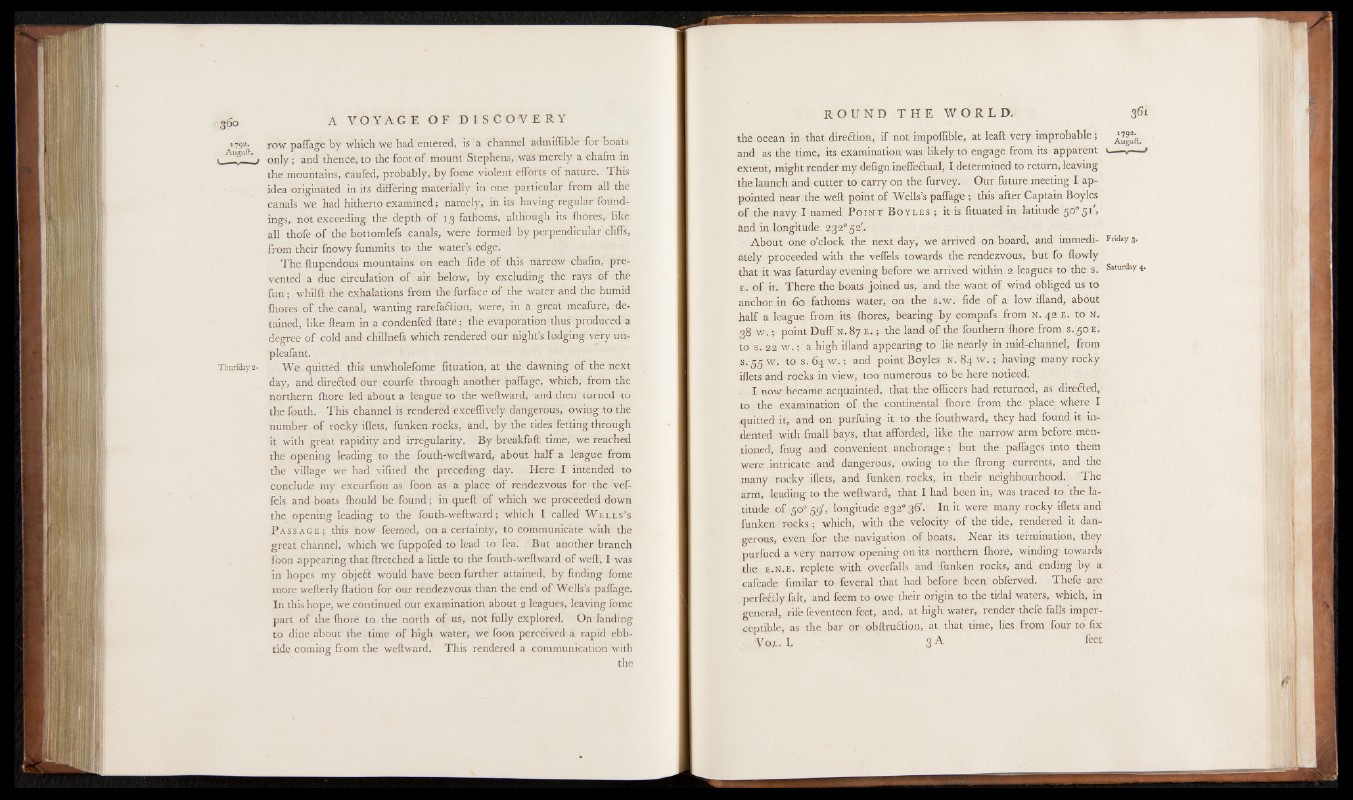
360
1792* row paffage by which we had entered, is a channel admiflible for boats
■ Augu ' ■ only; and thence, to the foot of mount Stephens, was merely a chafm in
the mountains, caufed, probably, by fome violent efforts of nature. This
idea originated in its differing materially in one particular from all the
canals we had hitherto examined; namely, in its having regular foundings,
not exceeding the depth of 13 fathoms, although its Ihores, like
all thole of the bottomlefs canals, were formed by perpendicular'cliffs,
from their fnowy fummits to the water’s edge.
The ftupendous mountains on each fide of this narrow chafm, prevented
a due circulation of air below, by excluding the rays of the
fun; whilft the exhalations from the furface of the water and the humid
Ihores of the canal, wanting rarefaftion, were, in a great meafure, detained,
like fleam in a condenfed Hate; the evaporation thus produced a
degree o f cold and chillnefs which rendered our night’s lodging very un-
pleafant.
Thurfday2* We quitted this unwholefome fituation, at the dawning of the next
day, and direfted our courfe through another paffage, which, from the
northern (hore led about a league to the weftward, and then turned to
the fouth. This channel is rendered exceffively dangerous, owing to the
number of rocky iflets, funken rocks, and, by the tides fetting through
it with great rapidity and irregularity. By breakfaft time, we reached
the opening leading to the fouth-weftward, about half a league from
the village we had vifited the preceding day. Here I intended to
conclude my excurfion as foon as a place of rendezvous for the vef-
fels and boats fhould be found; in quell of which we proceeded down
the opening leading to the fouth-weftward; which I called W e l l s ’s
P a s s a g e ; this now feemed, on a certainty, to communicate with the
great channel, which we fuppofed to lead to fea. . But another branch
foon appearing that ftretched a little to the fouth-weftward of weft, I was
in hopes my objeft would have been further attained, by finding fome
more wefterly ftation for our rendezvous than the end of Wells’s paffage.
In this hope, we continued our examination about 2 leagues, leaving fome
part of the Ihore to the north of us, not fully explored. On landing
to dine about the time of high water, we foon perceived a rapid ebbtide
coming from the weftward. This rendered a communication with
the
the ocean in that direction, if not impoflible, at leaft very improbable;
and as the time, its examination was likely to engage from its apparent <— ---- >
extent, might render my defign ineffectual, I determined to return, leaving
the launch and cutter to carry on the furvey. Our future meeting I appointed
near the weft point of Wells’s paffage; this after Captain Boyles
o f the navy I named P o in t B o y l e s ; it is fituated in latitude 50°51',
and in longitude 232°g2'.
About one o’clock the next day, we arrived on board, and immedi- Friday 3.
ately proceeded with the veffels towards the rendezvous, but fo flowly
that it was faturday evening before we arrived within 2 leagues to the s. Saturday 4.
E. o f it. There the boats joined us, and the want of wind obliged us to
anchor in 60 fathoms water, on the s.w. fide of a low illand, about
half a league from its Ihores, bearing by compafs from N, 42 E. to N.
38W. ; point Duff N. 87 E . ; the land o f the fouthern ftiore from s. 50 E.
to s. 22 w . -, a high illand appearing to lie nearly in mid-channel, from
S. 55 w. to s. 64 w . ; and point Boyles N. 84 w . ; having many rocky
iflets and rocks in view, too numerous to be here noticed.
I now became acquainted, that the officers had returned, as direfted,
to the examination of the continental ftiore from the place where I
quitted it, and on purfuing it to the fouthward, they had found it indented
with fmall bays, that afforded, like the narrow arm before mentioned,
fnug and convenient anchorage ; but the paffages into them
were intricate and dangerous, owing to the ftrong currents, and the
many rocky iflets, and funken rocks, in their neighbourhood. The
arm, leading to the weftward, that I had been in, was traced to the latitude
of 50° 59', longitude 232“ 36'. In it were many rocky iflets and
funken rocks ; which, with the velocity of the tide, rendered it dangerous,
even for the navigation of boats. Near its termination, they
purfued a very narrow opening on its northern Ihore, winding towards
the e .n.e. replete with overfalls and funken rocks, and ending by a
cafcade fimilar to feveral that had before been obferved. Thefe are
perfeftly fait, and feem to owe their origin to the tidal waters, which, in
general, rife feventeen feet, and, at high water, render thefe falls imperceptible,
as the bar or obftruftion, at that time, lies from four to fix
V ol. I. 3 a feet